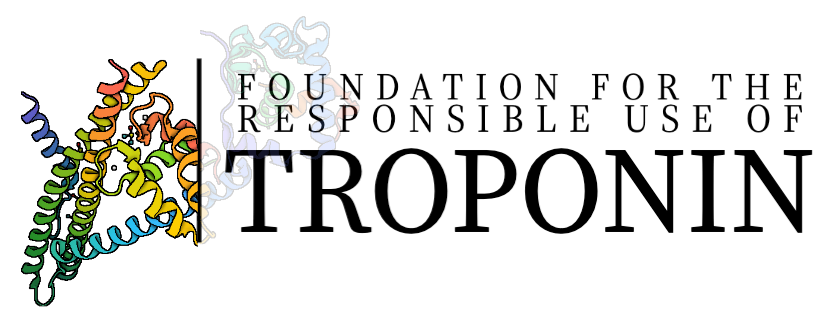
Definition of High Sensitivity
The hs-Tn assays measure Tn levels using similar immunological methods to fourth-generation assays, but with the capability of detecting much smaller concentra-tions. The term “high sensitivity” does not refer to one specific technology for meas-urement or one specific form of Tn being measured but refers to any assay that meets two criteria. First, its total imprecision, as defined by the CoV, at the 99th percentile value, is ≤10%. Second, measurable concentrations below the 99th percentile should be attainable at a concentration value above the assay’s limit of detection for at least 50% of healthy individuals [66]. Concentrations of hs-Tn are expressed in nanograms per liter (ng/L) or picograms per milliliter (pg/mL). The high performance of hs-TnT assays has yielded a sensitivity >94% and a negative predictive value ≥99% for possible MI among patients in the emergency department (ED) setting [67]. However, such high sensitivity has im-plications for clinical practice and has also yielded new insights into the basic biology of cardiovascular disease.
Conceptualizing Equivalence of Fourth-Generation and High-Sensitivity Values
As of 2024, there are eight hs-Tn assays approved by the FDA, seven of which detect TnI and one of which detects TnT [47]. The LoD of these assays ranges between 1–3 ng/L; the LoQ, between 0.9–6 ng/L; and the overall 99th percentile, between 17.5 (Beckman Coulter Access two hs-TnI) and 60.4 (Siemens Dimension ExL TnI) [47]. The conversion of values from conventional to high-sensitivity assay varies by manufacturer. With the Roche Elecsys hs-TnT (Roche Diagnostics GmbH, Mannheim, Germany), for example, values above 100 ng/L on the hs-TnT assay correspond linearly and 1:1 to values above 0.1 ng/mL on the conventional assay, so a value of 300 ng/L on the hs-TnT assay corresponds to 0.3 ng/mL on the conventional assay [68]. Values below 100 ng/L on the hs-TnT assay have a non-linear relationship: 52 ng/L hs-TnT corresponds to 0.03 ng/mL, and 30 ng/L corre-sponds to 0.01 ng/mL [69].
Clinical Implications of High-Sensitivity Troponin
Compared with conventional Tn assays, hs-Tn assays have higher negative predictive values for acute MI, meaning that a negative test result has a much higher certainty of truly representing the absence of acute MI. This reduces the “troponin-blind” interval, meaning that the time course for serial Tn checks can be shortened, resulting in a 4% absolute increase and 20% relative increase in the detection of type 1 MI, which conse-quently decreases the diagnosis of unstable angina due to the detection of abnormal Tn levels [50].
Because high-sensitivity assays can now detect serum Tn in an enlarged subset of patients without myocardial ischemia, clinicians must be more discerning when inter-preting results. Compared with conventional Tn assays, hs-Tn assays carry a two-fold increase in the detection of type 2 MI [50]. Additionally, as highlighted in the accom-panying companion review [1], many conditions other than ACS can present with ele-vations in serum Tn, including cardiac conditions such as tachyarrhythmia and noncardiac conditions such as pulmonary (e.g., pulmonary embolism), renal (end-stage renal dis-ease), neurologic (e.g., stroke), musculoskeletal (e.g., rhabdomyolysis), oncologic (e.g., when undergoing certain chemotherapies), and GI causes, as well as trauma (e.g., blunt chest trauma) and acute illness (e.g., sepsis) [70–73]. The etiology of the elevation can affect treatment. For example, patients with Tn elevation due to sepsis would not benefit from antithrombotic medications and PCI, while those with ACS would [74]. The use of more than one (e.g., two) cutoff points may facilitate clinical reasoning, with a more sensitive cutoff being good for ruling out ACS in the emergency setting, and a more specific cutoff being good for ruling in ACS and guiding treatment.
Furthermore, Tn levels between the LoQ and the 99th URL has been used in studies to identify patients at risk of coronary artery disease (CAD). One study showed that patients with intermediate Tn concentration (5 ng/L to the 99th URL) had a higher risk of MI and cardiac death in one year compared to patients who had a Tn concentration <5 ng/L (3.3% vs. 0.6%, p < 0.0001) [75]. Another study also suggested that patients with Tn of 5 ng/L to the 99th URL were three times more likely to have CAD and had a greater atherosclerotic burden as detected by coronary CT angiography compared to patients with Tn < 5 ng/L [76]. Thus, the increased sensitivity of Tn may allow it to play further roles in risk stratification, including with imaging.
Sex-Specific Considerations of High-Sensitivity Troponin
Notably, the distribution of hs-Tn values is not uniform across sexes. In both hs-TnT and hs-TnI assays, the 99th percentile URL in men is higher than the 99th percentile URL in women [77]. The same hs-TnT concentration may carry different prognostic implica-tions in men and women. For example, in one study of 19,501 individuals, at 10 ng/L, the hazard ratio for the composite outcome of cardiovascular death, myocardial infarction, or stroke was 9.7 (95% CI 7.6–12.4) for women and 5.6 (95% CI 4.7–6.6) in men, relative to the limit of blank [78]. Use of sex-specific thresholds may increase the diagnosis of MI in women. Similarly, in a prospective cohort study of 1126 patients with suspected ACS, the use of sex-specific thresholds for hs-TnI substantially increased the diagnosis of MI in women (11% to 22, p < 0.001) and had a minimal effect on the diagnosis of MI in men (19% to 21%, p = 0.002) [79]. However, the increased diagnosis rate may not necessarily have an effect on prognosis. In SWEDEHEART, the use of sex-specific hs-TnI cutoffs in 12,489 patients increased incidence of acute MI by 11.5% (female) and 9.8% (male), but had no major effect on cardiovascular outcomes after multivariable adjustment (HR 0.91 [95% CI 0.80–1.03], p = 0.126) [80]. Further research is needed on the role of sex-specific strategies for hs-Tn-based diagnosis and management.
Gokhan I, Dong W, Grubman D, Mezue K, Yang D, Wang Y, Gandhi PU, Kwan JM, Hu J-R. Clinical Biochemistry of Serum Troponin. Diagnostics. 2024; 14(4):378. https://doi.org/10.3390/diagnostics14040378
